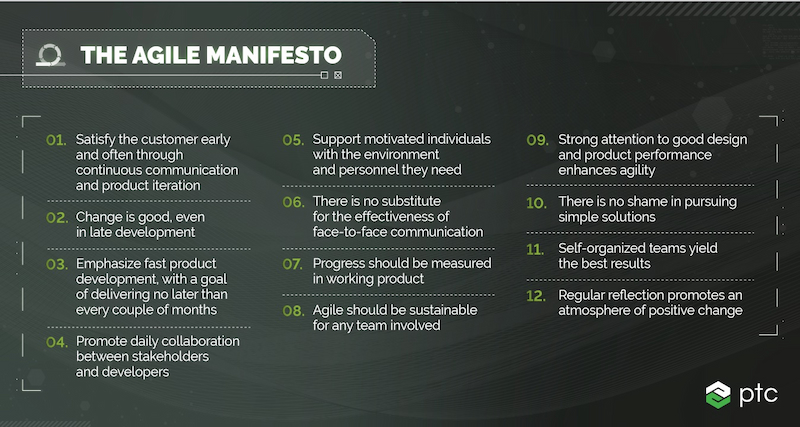PTC: What Is Agile Product Development?
Agile isn’t new. Like SaaS, the cloud, and many technologies revolving around the concept of digital transformation, many write about Agile as a ubiquitous aspect of the future. Yet, for many hardware manufacturers, this creates a disconnect. They’re very likely aware of Agile, it’s true…but Agile as a software development philosophy. Agile product development in the context of physical products is another reality altogether, one that many still question.
Agile product development, as its name implies, is the application of software methodology to a physical manufacturing process. In a sense, building a product using Agile or – to be more blunt – making hardware like making software.
For the purposes of this blog, we won’t be fully exploring the potential of Agile product development (as it would take far too long) but rather offering an overview, answering questions like: Where did Agile come from? How can a software development philosophy make sense in manufacturing? And what is the current reality of Agile product development?
Agile’s History in Software
While the exact origins of the principles of Agile is unknown, we do know when the terminology fully took shape. The Agile Manifesto was created in 2001 when 17 software developers convened to discuss the potential and strategies behind lightweight development philosophies. As this history suggests, it was purely in the realm of software. The manifesto can be broken down into 12 core principles and four central values, all of which are geared toward facilitating higher levels of collaboration, greater transparency, and faster time to product delivery.

After its debut, the Agile Manifesto quickly became commonplace in software, seen by many as a universal positive. True to its design philosophy, using Agile increased productivity, improved product delivery times, and strengthened communication between teams – especially when work was distributed.
Yet, while all of these positives were felt in the software space, many in hardware had doubts about Agile’s applicability. The work done in Agile is broken into sprints – fast, preset durations of work that usually last weeks and end with a deliverable product. Possible in software, seemingly impossible in hardware – at least when sprints must be weeks, and if the desired outcome at the end of every sprint is solely a useable product.
Why Agile Makes Sense in Hardware
The idea of multiple iterations seems, at first glance, to negate the applicability of Agile in product development. It is not feasible to consistently produce a useable product only to immediately iterate upon it in the next sprint, over and over, until a final is produced. This reasoning is in large part why many manufacturers have assigned Agile as solely a software tool.
The reality, however, is more complex and comes down to an issue of adoption vs. adaption. Merely adopting Agile principles, word for word, can create unreasonable demands for hardware manufacturers. Adapting Agile into a hardware mindset, by contrast, brings the best of Agile to the manufacturing space. Let’s break it down a little more.
All product developments have a lifecycle from conception to product release. Sprints are simply another way of breaking down the stages of the lifecycle. The main point of a sprint is to have a directed, achievable goal. In software, this most often translates to releasing a product. For hardware, however, the end goal doesn’t need to be so literal. Measurable progress is enough and can help break even complex hardware development down into clear, cohesive segments.
Even regulated industries such as healthcare can make use of Agile. If the average product development cycle is two years, manufacturers should think about what can realistically be done in six months. A two-year cycle becomes four sprints, complete with check-ins and product evaluation. By using Agile, manufacturers give themselves benchmarks, team check-ins, and greater transparency into the hardware development process.
The Reality of Agile Product Development
The idea of distributed hardware manufacturing is not new. In fact, for many companies, distributed production has been the reality for decades – if not longer. Agile product development is simply about giving hardware manufacturers modern tools to maximize the capacity for distributed work. This goes beyond Zoom and other video conferencing software to a new mindset that prioritizes cross-team collaboration and improves internal dialogue and cooperation.
Communication and collaboration matter today, more than ever. There is growing uncertainty in the market, driven in part by customer expectations. Customers know what they want, and they want it quickly – shrinking the expected time to market. Organizations also must battle supply chain uncertainty, changing global conditions, and a host of other complications.
Agile product development applies the best of the Agile Manifesto – including increased internal communication between departments and stakeholders, frequent product development check-ins, clearly outlined objectives, and self-organized, highly motivated team structure – and brings it to the hardware space. Organizations do not have to fully adopt Agile to see its benefits. Every company is different and Agile is designed to be flexible. As we alluded to earlier, the path to success often flows through adaption rather than adoption. Agile product development can help organizations innovate faster while delivering superior products and navigating around uncertainty in an increasingly volatile world.
This content was first published on the PTC website.

